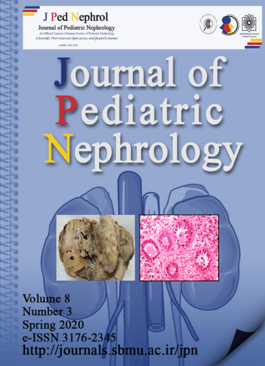Continuous Ambulatory Peritoneal Dialysis in Children: Experience from a Tertiary Care center of Bangladesh
Journal of Pediatric Nephrology,
Vol. 8 No. 3 (2020),
20 July 2020
,
Page 1-5
https://doi.org/10.22037/jpn.v8i3.30716
Abstract
Background:
Continuous ambulatory peritoneal dialysis (CAPD) is the most commonly used modality of renal replacement therapy (RRT) in children in different parts of the world. There is a paucity of published experience of CAPD in children from developing countries and also from Bangladesh.
Methods:
We retrospectively studied children with end-stage renal disease (ESRD) that had been on CAPD from January 2014 to December 2018 in a tertiary care center of Bangladesh, over the past 5 years. The objective was to assess the clinical and biochemical profile, complications encountered and outcome of children on maintenance CAPD.
Result:
Seven patients with ESRD were analyzed, mean age was 103months (range 28-168 month), 4 were male and three were female. CAPD was done in 2014 to a 7year old girl and subsequently 6 patients underwent CAPD. Outcome analysis of CAPD showed that only 6 episodes of peritonitis occurred among these 7 patients. Their follow up parameters showed that they are performing very well in context of growth, biochemical parameters and albumin level but one patients died due to sepsis and poor adherence.
Conclusion:
It can be concluded from these series of CAPD patients that CAPD could be a good choice of RRT in children in Bangladesh. It can reduce the uremic features as well as improve health status- Children
- Continuous ambulatory peritoneal dialysis
- End stage renal disease
How to Cite
References
Warady BA, Chadha V. Chronic kidney disease in children: the global perspective. Pediatr Nephrol. 2007 Dec; 22(12):1999–2009.
Fadrowski J, Alexander SR, Warady B: The demographics of dialysis in children. In: Pediatric Dialysis, edited by Warady BA, Schaefer F, Fine RN, Alexander SR, Dordrecht, The Netherlands, Kluwer, 2011, 37–51
North American Pediatric Renal Trials and Collaborative Studies (NAPRTCS): Annual Dialysis Report, 2011
Szeto CC, Chow KM, Wong TY, Leung CB, Li PK: Influence of climate on the incidence of peritoneal dialysis-related peritonitis. Perit Dial Int 2003; 23: 580–586.
Katz IJ, Sofianou L, Hopley M. An African communitybased chronic ambulatory peritoneal dialysis programme. Nephrol Dial Transplant 2001; 16:2395–2400
Renske Raaijmakers & Priya Gajjar & Cornelis Schröder & Peter Nourse. Peritonitis in children on peritoneal dialysis in Cape Town, South Africa: epidemiology and risks. Pediatr Nephrol 2010; 25:2149–2157
Chadha V, Schaefer FS, Warady BA: Dialysis-associated peritonitis in children. Pediatr Nephrol 2010; 25: 425–440.
Aksu N, Yavascan O, Anil M, Kara OD, Efdogan H, Bal Al. A ten-year single centre experience in children on chronic peritoneal dialysissignificance of percutaneous placement of peritonel dialysis catheter. Nephrol Dial Transplant.2007 Jul;22(7):2045-51. Epub 2007
Van Esch S, Krediet RT, Struijk DG. 32 years' experience of peritoneal dialysis-related peritonitis in a university hospital. Perit Dial Int 2014; 34:162–70.
Zent R, Myers JE, Donald D, et al. Continuous ambulatory peritoneal dialysis: an option in the developing world? Perit Dial Int 1994;14:48–51.
Raaijmakers R, Gajjar P, Schröder C, et al. Peritonitis in children on peritoneal dialysis in Cape Town, South Africa: epidemiology and risks. Pediatr Nephrol 2010; 25:2149–57.
Nieto-Ríos JF, Díaz-Betancur JS, Arbeláez-Gómez M, et al. Peritoneal dialysis-related peritonitis: twenty-seven years of experience in a Colombian medical center. Nefrologia 2014; 34:88–95.
United States Renal Data System (USRDS). ESRD among children, adolescents, and young adults. In: Annual Data Report. Michigan; 2018. p. 463–500
Fraser N, Hussain FK, Connell R, Shenoy MU. Chronic peritoneal dialysis in children. Int J Nephrol Renovasc Dis. 2015;8:125–37.
North American Pediatric Renal Trials and Collaborative Studies. 2011 Annual Dialysis Report [Internet]. Boston: NAPRTCS. 2011 [cited 2012 Aug 1] Available from: https://web.emmes.com/ study/ped/annlrept/annualrept2011.pdf.
Schaefer F, Borzych-Duzalka D, Azocar M, Munarriz RL, Sever L, Aksu N, et al. Impact of global economic disparities on practices and outcomes of chronic peritoneal dialysis in children: insights from the International Pediatric Peritoneal Dialysis Network Registry. Perit Dial Int. 2012;32(4):399–409.
Hagen SM, Lafranca JA, IJzermans JN, Dor FJ: A systematic review and meta-analysis of the influence of peritoneal dialysis catheter type on complication rate and catheter survival. Kidney Int 2014; 85: 920–932
Moncrief JW, Popovich RP, Broadrick LJ, He ZZ, Simmons EE, Tate RA: The Moncrief- Popovich catheter. A new peritoneal access technique for patients on peritoneal dialysis. ASAIO J 1993; 39: 62–65
- Abstract Viewed: 209 times
- PDF Downloaded: 147 times

